Notice Board 2022
The notice board is one of the principal modes of communication
for those interested in VC32 moths. I am keen to keep this resource active throughout
the year and will be happy to post interesting sightings or issues. In general,
at the time of recording I would like to hear of moths that are UK
BAP species, new to the county, very localised or rare, or which have not been recorded since 2000.
Additionally any exceptional or interesting captures,
i.e. very high numbers, species seen out of season and unusual extremes of variation
or melanism etc. will be welcome.
All other records can be submitted at the end of the season for
inclusion in the central database.
Site Images: We are keen to complete the species illustrations on the site,
additionally some of the earlier photographs now look below par and could be
improved. If anyone has photographs of the species that we have not yet pictured,
or clear improvements, and does not mind us using them to fill some of our gaps
will they please let the County Moth Recorder Mark Hammond know.
Any photographs used will of course be acknowledged.
The up to date grid square coverage map is now
available by clicking onto:
Request for
Information/Records from the County Recorder
IDENTIFICATION AND NOTICE BOARD ENTRIES:
Any member of the group is able to handle identification queries
on moths at any of their stages and if in doubt will refer the matter on for
a second opinion. At the outset the insect should be retained and a realistic
photograph provided to confirm the identity. Due to the limitations sometimes
imposed by photographic images of moths it is not always possible to identify
difficult species from a photograph alone. Basically there is always a preference
for a moth in the hand. Accordingly if there are still doubts the actual insect
should then be seen by either Mark Hammond, Philip Horsnail or Pete Sharpe who will act as determinors.
Home
2022 Records and Notices:
22nd November 2022
A report of a single Humming-bird Hawk-moth Macroglossum stellatarum flying around the garage light in the afternoon in Old Stratford (SP74). This is the second-latest record that I can find on record - the latest being one seen on 9th Dec 2019.
Belated records:
Following some recent "lab work" and dissections, etc, I can report a further two records of Lyonetia prunifoliella as follows:
3rd August 2022 - Single adult taken at light in an Oundle garden (TL09)
22nd September 2022 - Single adult taken at light in an Thrapston garden (SP97)
These two records follow-on from the finding of tenanted leaf-mines in the grounds of Burghley House near Stamford (TF00), on 8th August 2022 (reported below).
5th November 2022
What better way to celebrate Bonfire Night than with a rare migrant moth? Another single Palpita vitrealis was recorded to light at Pitsford Reservoir (SP77).
27th October 2022
Amidst a period of apparently significant UK-wide moth migration, a single Etiella zinckenella was recorded to light at Ring Haw (TL09). This is the 1st VC32 record of this rare migrant to the UK mainland. The UK Moths website states that there have been "a handful of records of this species since the first in 1989", but I am unaware of exactly how many have been recorded in the UK to date. Whatever that number might be, this is a vary significant record for The Midlands. This record was accompanied by a putative Plumed Fan-foot Pechipogo plumigeralis - the moth is badly worn and thus will require dissection to be certain, but if it is proved to be this, then would be a 2nd VC32 record. Not a bad night out that Ron!
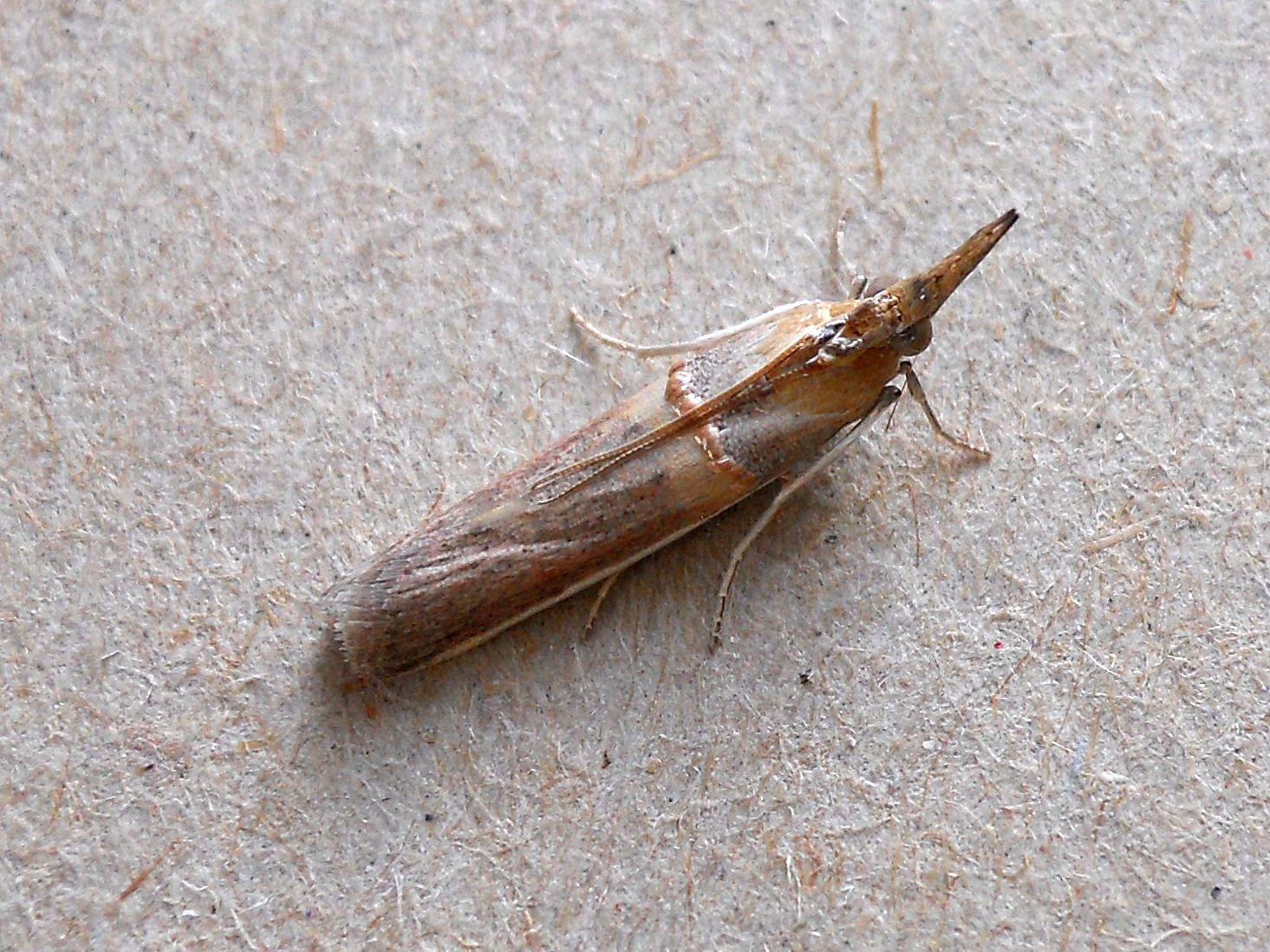
25th October 2022
A single Palpita vitrealis was recorded to a garden light trap in Rothwell (SP88). I believe this to be the 11th all-time VC32 record for this rare migrant species. I noted that several others were reported on social media around this date - many in neighbouring counties and even further north, so presumably there was an influx of this species across the UK during this period.
23rd October 2022
A single tenanted mine of Ectoedemia agrimoniae was located at Farthinghoe NR (SP54). Despite much further searching, no others were found. Text books list Agrimony, Agrimonia eupatoria, as the main foodplant, and that the species prefers chalk downland. The mine was actually located on Fragrant Agrimony, Agrimonia procera, which I note is listed as a possible larval foodplant on the lepiforum.org website (https://lepiforum.org/wiki/page/Ectoedemia_agrimoniae). This is the first VC32 record for this predominantly south-eastern species.
*********************************************************************************************************************************************************************************************
David Manning
I am saddened to report that David passed away peacefully in his sleep on Friday morning, 30th September 2022.
For those who have been "doing moths" for a few years will remember that David was the County Micro-moth Recorder for both Bedfordshire (VC30) and Northants for many years, until he finally retired at the end of 2015. David initially was the County Micro-moth Recorder for VC30, but later became a key figure in the recording of micro-moths in VC32, responding to a request by the late Maitland Emmett to "fill-in some gaps" as part of the publication of the book series, The Moths & Butterflies of Great Britain & Ireland. To that end he added numerous micro-moth species to the VC32 list. He specialised in finding and identifying leaf-mines, and thus many of his County Firsts were derived in this fashion. David also therefore made a significant contribution to the British Leafminers website, which has become one of the go-to web resources for identifying mines.
David suffered a serious fall some three years ago, which had a subsequent and significant impact on his mobility, and thus he was unable to pursue his passion in the last couple of years. I'm sure that this would have been very frustrating for him, as he was still actively recording leaf-mines in the region up until that point.
David spent a not inconsiderable amount of time when he handed the VC32 micro-moth recording job to me in late 2015/early 2016. We spent many happy sessions poring over his microscope as he brought me a bit more up-to-speed on the finer art of dissection techniques and identification. One abiding memory for me was sharing a train trip into London 4 or 5 years ago, to attend the annual BENHS Exhibition, whilst loudly discussing the merits and pitfalls of the study of genitalia...much to the amusement (and possibly consternation) of our fellow passengers. I for one will miss his sage words of advice, and his enthusiastic encouragement.
*********************************************************************************************************************************************************************************************
28th September 2022
Vacated mines of Phyllonorycter mespilella were located on Whitebeam in the grounds of Sulgrave Manor (SP54). The 3rd VC32 record; the two previous records for this species being of adults from 1936 and 1999.
21st September 2022
The first county record since 2013 of Pale-lemon Sallow Cirrhia ocellaris was noted to light in Fineshade (SP99). There appear only to be nine all-time previous records, and only four of those since 2000 too.
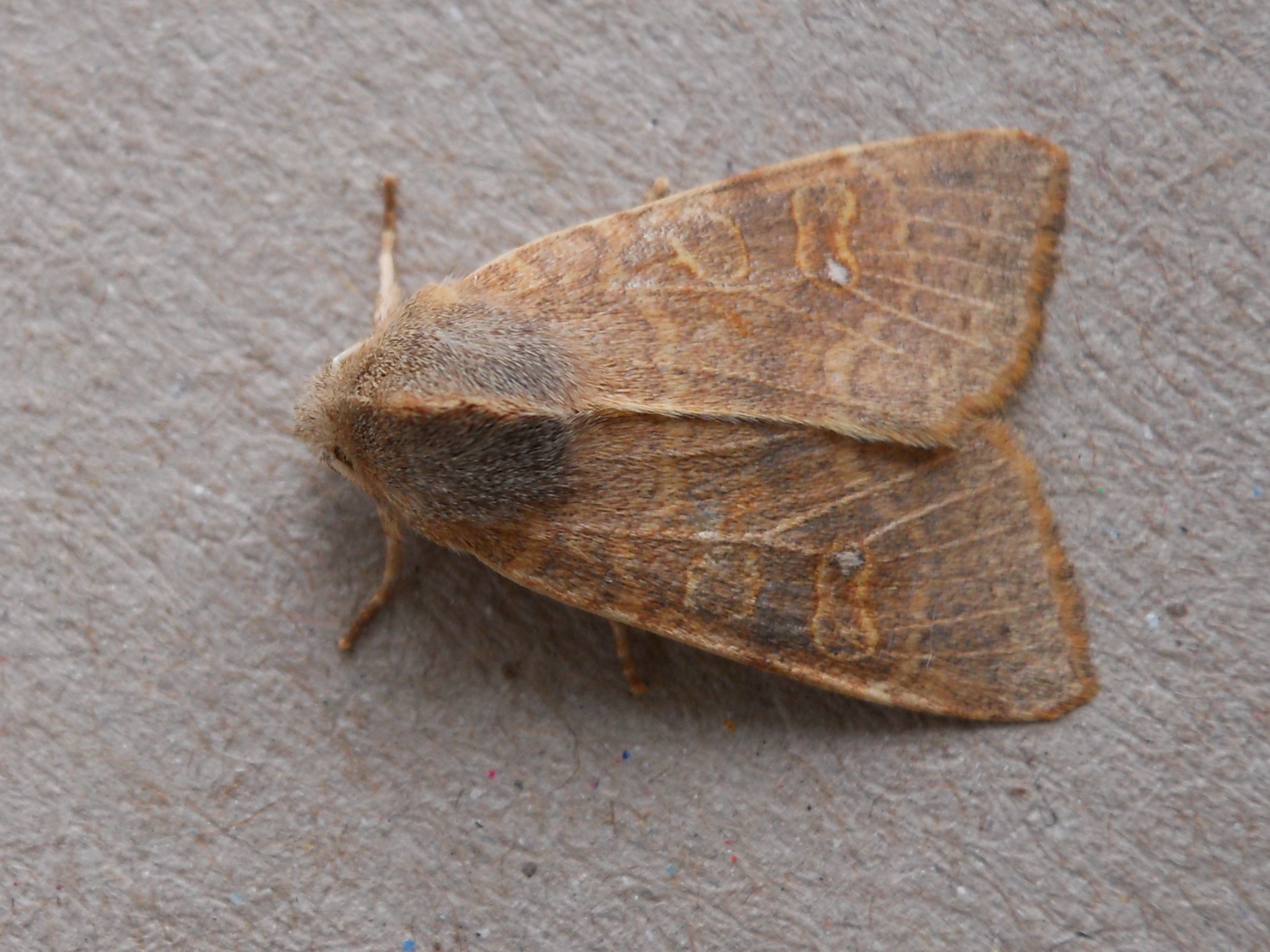
Dissection news
Two Elachista consortella from Farthinghoe NR (SP54) - 15th and 17th August. These are the 3rd and 4th VC32 record. There are no modern/post-2000 records for this species in VC32.
A result that I forgot to place on record at the time of the dissection (apologies Peter!) was of a single Epinotia cinereana noted from material from a Denton garden (SP87) from 21st July 2022. This is the 2nd confirmed VC32 record.
From the group trip to Salcey Forest (SP85) on 6th August 2022 were two Elachista obliquella. These are new to VC32.
16th September 2022
Several mines of Cosmopterix zieglerella were located in an Oundle garden (TL09) on Hop. This is the 4th VC32 record. The mines stand out as uneven pale brown galleries and blotches along the midrib, although care must be taken to eliminate those made by e.g. flies on the same plant.
14th September 2022
A single Plumed Fan-foot Pechipogo plumigeralis was taken in a garden light trap in Oundle (TL09). This is the 1st VC32 record of this species. This individual moth is most likely to have been a migrant individual, possibly dispersing from sites where it is known to be breeding within the UK.
14th September 2022
More mines (4 in total) of Phyllocnistis xenia have been located on White poplar, this time at Farthinghoe NR (SP54). I believe these to be the 4th VC32 record.
12th September 2022
Found upon a small stand of White Poplar whilst on a stroll around Kinewell Lake at Ringstead (SP97) were several mines of Phyllocnistis xenia. All the Poplar trees were fairly immature and thus the leaves were at a height that made searching very easy. Several of the leaves had the edge-fold on the upper surface, containing the pupa. This is the 3rd VC32 record of the species.
11th September 2022
A further record of Lyonetia prunifoliella has been noted, of several vacated mines on the Farthinghoe NR site (SP54). The mines exhibited the characteristic external "string of beads" frass. This represents the 3rd VC32 record.
5th September 2022
A single Striped Hawk-moth Hyles livornica was recorded in a garden light trap in Kingsthorpe, Northampton (SP76). This I believe is the 7th all-time VC32 record, and 2nd this year.
4th September 2022
A very unusual sighting in Kingsthorpe, Northampton (SP76): approximately 20 The Vestal Rhodometra sacraria were noted along a short daytime walk. It is hard to believe that these are anything other than the result of local breeding.
4th September 2022
The garden traps in Helpston (TF00) have resulted in another interesting catch, on this occasion another Ancylosis oblitella. I think this is now the 8th all-time/5th post-2000 record, hot on the heals of three others this year.
3rd September 2022
The final group over-night field trip of the year proved to be quite productive, with over 100 species being recorded (final list in-prep) to 16 light traps deployed around the privately-owned woodland on the Bulwick Estate (SP99). Highlights included four Clifden Nonpareil Catocala fraxini, another Ancylosis oblitella (7th VC32 record), a single Mompha langiella (also 7th VC32 record/5th post-2000 record) and approximately 200 Beet Moth Scrobipalpa ocellatella! NB: further dissection work has also revealed a single Elachista stabilella (9th all-time VC32 record/4th post-2000 record)and the 3rd confirmed VC32 record of Epinotia cinereana.
2nd September 2022
Another record of a Bedstraw Hawk-moth Hyles gallii - this one taken in a garden light trap in Sywell (SP86).
2nd September 2022
A rare migrant which seems to "be having a good year" - two singletons of
Loxostege sticticalis were recorded - one in a garden light trap in Peterborough (TL19), and the other in Helpston (TF10), also in a garden light trap. These are therefore the joint 4th VC32 records, the last being in July 2013 (oddly, also in Peterborough).
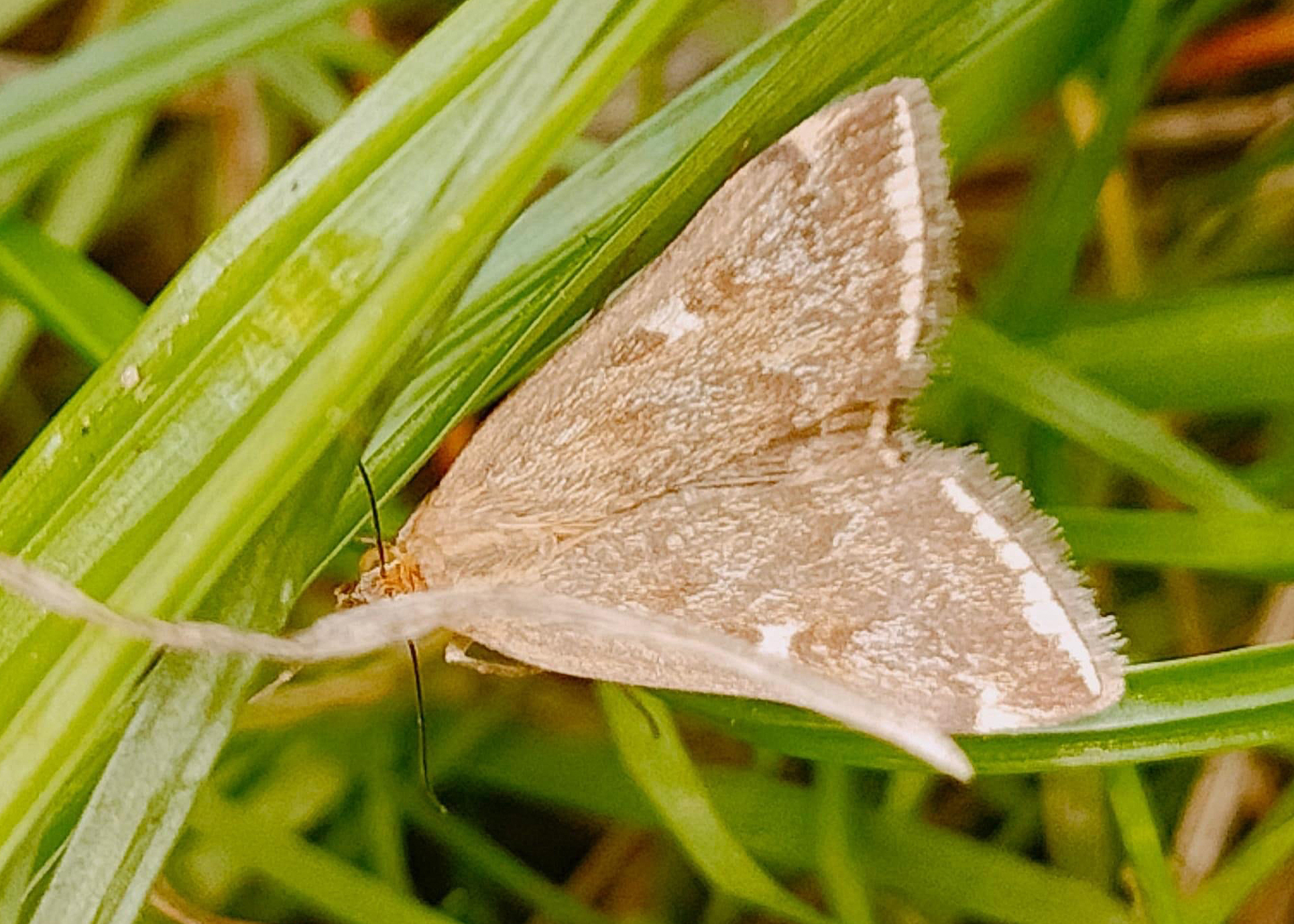
Pitsford Reservoir Traps
Reports of further Dark Crimson Underwing Catocala sponsa being seen in the Pitsford traps - with five being recorded since the one noted on 20th August. These do appear to be different individuals, and not re-captures of the same, light-addicted moth!
28th August 2022
Another Ancylosis oblitella has been recorded, this time to light at Nether Heyford (SP65). This is the second record of this migrant species this year (that I know about), the 6th all-time and 3rd post-2000 VC32 record. This moth was much darker than others I have seen.
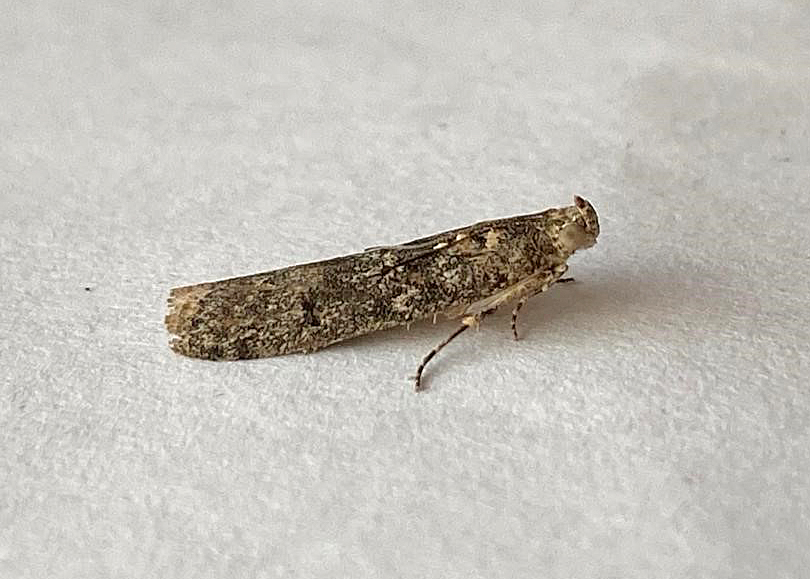
26th August 2022
A single Golden Twin-spot Chrysodeixis chalcites was recorded to light in Nether Heyford (SP65). This is the 2nd VC32 record, and the first of an adult to light. Prior to this, the only other VC32 record came in 1997 at Sywell (SP86), with an adult moth being seen indoors. The origin of that moth was most likely imported in some cut flowers that were purchased from a local Tesco store. Subsequent investigations revealed an empty pupal case in a rolled up rose leaf amongst the bouquet. Enquiries of the importer revealed that the flowers were most likely to have come from Kenya. The true origin of such exotica in the Midlands will always pose some queries as to whether it is a primary migrant (this far from coastal locations...) or an adventive which has found its way here with assistance from the horticultural trade. That said, there has been a significant number of other migrant species recorded in the county in the last few days/week, with a Convolvulus Hawk-moth on 22nd August in Sywell and numerous Bordered Straws being taken over the county in the past few days, including one in the same trap as this Golden Twin-spot.
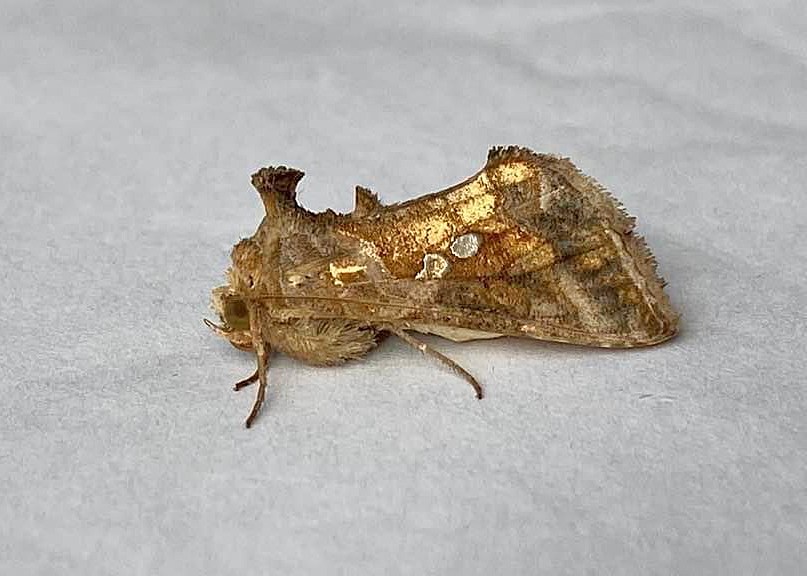
23rd August 2022
The 2nd VC32 record of Phyllocnistis xenia was noted on a small (regularly pollarded!) Grey Poplar in a Thrapston garden (SP97). The mine was tenanted, although the larva had excited the mine to form its cocoon on the edge of the upperside of the leaf. Despite further vigorous searching, only that single mine was found.
Dissection news
A number of Bryotropha basaltinella were confirmed from a single site in Helpston (TF00), all caught inside a thatched property. These effectively constitute the 4th VC32 record (although they were caught over a period of a few days). All proved to be male, but looked suitably different to B. domestica, which are far more widespread and often found inside houses. Also confirmed was the presence of Beet Moth Scrobipalpa ocellatella from the site, with a mix of male and female moths being taken at light during early to mid August. This constitutes the second confirmed site for the moth in VC32, but note that there are several other moth recorders around the county who have indicated possible presence and who have retained specimens for confirmation.
Pitsford Reservoir Traps
A couple of recent records from the two light traps located at the reservoir site include a further Dark Crimson Underwing Catocala sponsa taken on 20th August, and two Clifden Nonpareil Catocala fraxini on 22nd August.
Species News Update:
Beet Moth Scrobipalpa ocellatella
So it seems that this moth is now putting in appearances in several nearby counties, sometimes in fairly significant numbers (The VC29/Cambs CMR reported "several hundered" from Anglesey Abbey last night for instance!). I have so far received putative records for the moth at Helpston (TF10) and Cogenhoe (SP86), which require confirmation, but certainly look likely from images submitted. I have also noted another four specimens in Thrapston (SP97), following the one from 1st August, which will be examined shortly. The National Moth Recording Scheme calls for it to be dissected to prove identification, but it appears that in areas where it is known to be well-established, records are being accepted if submitted by an experienced recorder/or with a decent image. So for the time being, if you do catch something that looks to be a good candidate (see below), please retain one or two specimens and send to me for dissection. I'm sure that we will find this moth to be present in many areas of VC32, and thus once confirmed from a "new site" I will be happy to accept records based on a good, clear photograph, which can be submitted at the time of capture, or with the year-end record submission (or, e.g. attached to the record on iRecord). Note that these moths are quite small, and are highly active, both at night and in the morning when opening the moth traps...!!!
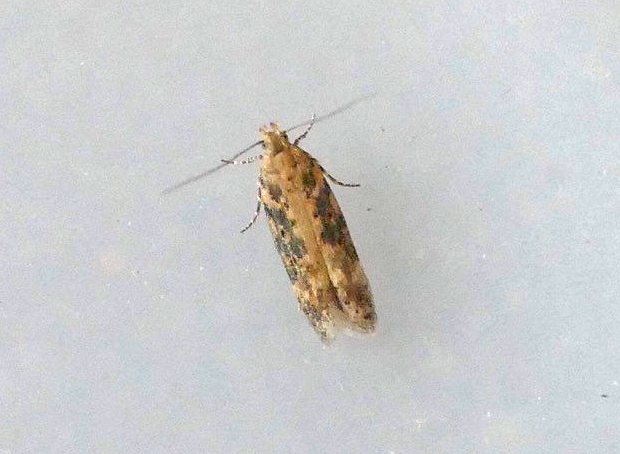
13th August 2022
Two migrant Hawk-moths to report:
The first is of a single Striped Hawk-moth Hyles livornica, taken in a garden light trap in Helpston (TF10) - the 6th VC32 record.
The other is of a Bedstraw Hawk-moth Hyles gallii, also taken in a garden light trap, this time in Duston, Northampton (SP76).
Retrospective record: 8th August 2022
A hoped for, but very warmly welcomed report of Lyonetia prunifoliella has been received. Several tenanted mines were located on Prunus in the grounds of Burghley House near Stamford (TF00). This represents probably the 2nd VC32 record, with the only other sighting being made in the late 19th Century! That one previous record is in some question, given the possibility that the record is a duplicate of one from North Bucks around the same period and area. This species was subsequently presumed extinct in the UK in the early 20th Century, until the last ten or so years, with sporadic records being noted in southern and eastern counties.
Retrospective records from Helpston (TF10):
Platytes alpinella - one caught to light on 11th August. This is the 4th VC32 record.
Aristotelia ericinella, also caught on 11th August. This is the 3rd VC32 record, following on from another taken in Oundle on 20th July.
A single Oblique Carpet Orthonama vittata taken to light on 10th August. Last recorded in VC32 in 2017, but only the third record since 2000.
11th August 2022
A single Ancylosis oblitella was the star appearance amongst a relatively poor overnight catch in Thrapston (SP97). This represents the 5th VC32 record.
1st August 2022
Another new species for VC32: a single Beet Moth Scrobipalpa ocellatella was recorded in a garden light trap in Thrapston (SP97). Although externally, the moth looked to be a good fit for this species, the Scrobipalpa can be quite hard to separate and is a Grade 4 moth as per the NMRS rules. The moth identification was subsequently confirmed by dissection. A possible vagrant, this species is normally seen around coastal or saltmarsh locations, although it appears the moth has been recorded at other inland sites around the same time. This could reflect a large dispersal event, and/or maybe that the moth is utilising other Beet species as larval pabulum.
Retrospective record following dissection: 21st July 2022
A single Bryotropha desertella was taken at light on Farthinghoe NR (SP54). This is new to VC32. The species is primarily recorded on coastal sand dunes, but is known to "wander". Yet to record one this far inland is somewhat unusual.
Retrospective record: 7th May2022
Resulting from a batch of catch-up dissection work, a single Elachista poae was confirmed, taken in Fermyn Woods (SP98) on 7th May 2022. This is the 4th VC32 record, after three records near Peterborough in 2021.
23rd July 2022
A record of Sallow Clearwing Synanthedon flaviventris to the SAL pheromone lure in a garden at Nether Heyford (SP65). There may be others that I've not heard of this year, but this adds to the eight records noted during 2020. NB: further previous records for the species that I know of: Cogenhoe (SP86), 9th July and Farthinghoe NR (SP54) on 11th July.
23rd July 2022
A further examnple of Dark Crimson Underwing Catocala sponsa was recorded in a garden light trap in Higham Ferrers (SP96). This is the first one I have heard of this year, and therefore likely to be the 7th all-time VC32 record of this apparently spreading species.
22nd July 2022
A single Duponchelia fovealis was recorded to light in a garden trap in Oundle (TL09). The moth is most likely an adventive, coming in with horticultural stock or nearby garden planting. This is however only the 5th VC32 record of this attractive Crambidae species. Previous examples have been recorded in and around Northampton, aside from another singleton seen earlier this year inside a domestic residence in Rothwell (14th January).
Retrospective record: 8th July 2022
The use of pheromone lures to attract the Clearwing species is now a widely established technique. There are however, numerous lures available which will attract a wide range of species. However, many lures will also attract "non-target species", and these attractions are becoming better understood and documented. An example of this was encountered using the LUN lure (intended to attract Lunar Clearwing) in Fineshade (Far Markham's Wood, SP99). The lure was left in-situ overnight in a lure trap, hanging off an Oak tree. Upon inspection in the morning, the trap had a single occupant, which looked to be a Tineid. After subsequent dissection of the specimen, it proved to be a male Triaxomasia caprimulgella. This is only the 2nd VC32 record, the first resulting from a larva collected from the rot hole of a felled Horse Chestnut or Wych Elm (captor unsure which) on 10th March 1985. the moth was succesfully reared and retained, but only identified by dissection in 2021! Also of note, three male Nemapogon ruricolella were recorded to the VES lure on the same night and location, a species which so far has only been recorded in VC32 using this method.
20th July 2022
A new species for Northants: A single Mecyna flavalis was recorded to light in a garden light trap in Kingsthorpe, Northampton (SP76). That the species is normally seen on chalky habitats and on cliffs around the south of England and Wales suggests that this individual is an adventive specimen.
20th July 2022
A single Aristotelia ericinella was recorded in a garden light trap in Oundle (TL09). This is only the 2nd VC32 record for this species. The larvae feed on Heather, and thus this individual priobably represents an adventive individual from a nearby garden planting.
20th July 2022
Another example of Monochroa palustrellus has ben recorded, this time in a garden light trap in Wollaston (SP96). This therfore is the 5th VC32 record for the species, close on the heals of another reported on 12th July.
20th July 2022
Always worth keeping an eye on Lesser Broad-bordered Yellow Underwings in the county, as amongst these was a single Langmaid's Yellow Underwing Noctua janthina, taken in a garden light trap in Oundle (TL09). Probably the 3rd VC32 record for the speices. This species has so far only been seen sparingly and intermittently at one site in Kingsthorpe, Northampton. I still think those moths recorded in VC32 represent migrants.
18th July 2022
Farthinghoe NR (SP54) has produced yet another good moth, in a single Yponomeuta sedella to light. This is only the 4th VC32 record. The larvae feed on Orpine, but are also known to feed on cultivated Sedum plants.
12th July 2022
In amongst an approximately 200 species catch was a single Monochroa palustrellus, taken at a previously un-surveyed private quarry site near Northampton (SP76). This represents only the 4th VC32 record for the species.
11th July 2022
A single Goat Moth Cossus cossus has been taken in a light trap in Helpston (TF00). This is only the second time that the moth has been recorded in VC32 since 1988, with both modern records being in or near to Peterborough.
8th July 2022
Sadly, this is a tale of "the one that got away". Fortunately the moth is very easily identifiable. A single Beautiful Snout Hypena crassalis was recorded in a garden light trap in Duston, Northampton (SP76). The moth was seen upon opening the trap, but immediately took to flight! The moth must be regarded as an adventive here in the county, and likely to have originated from planted Heathers in nearby gardens, or possibly from garden centre stock in the nearby region. This sighting constitutes only the 2nd VC32 record, with the only other being from pre-1940 at Castor Hanglands, presumably from a time prior to the degradation and loss of the heathland on that site.
Retrospective record: 23rd June 2022
A single larva of Clifden Nonpareil Catocala fraxini was seen on the ground in Fermyn Woods (SP98). This is the first record that I know of the larvae of this rapidly spreading species being seen within the Vice County.
Retrospective record: 17th June 2022
A single Haplotinea insectella was taken in a garden light trap in Thrapston (SP97). The moth was quite worn and subject to dissection. This is the 4th VC32 record, and second for the site. Note a further specimen was netted at the same site (indoors) on 28th June (which made a very pleasant change from all the T. pellionella that are usually seen here...!).
28th June 2022
Several vacated mines of Ectoedemia minimella have been located on Birch at Farthinghoe NR (SP54). This is the 3rd VC32 record, and first for twelve years.
22nd June 2022
A single Evergestis limbata was taken in a garden light trap in Helpston (TF10). This is the first VC32 record for this migrant species, which is very rarely seen in the Midlands. The catch also included a single Vestal, another migrant species.
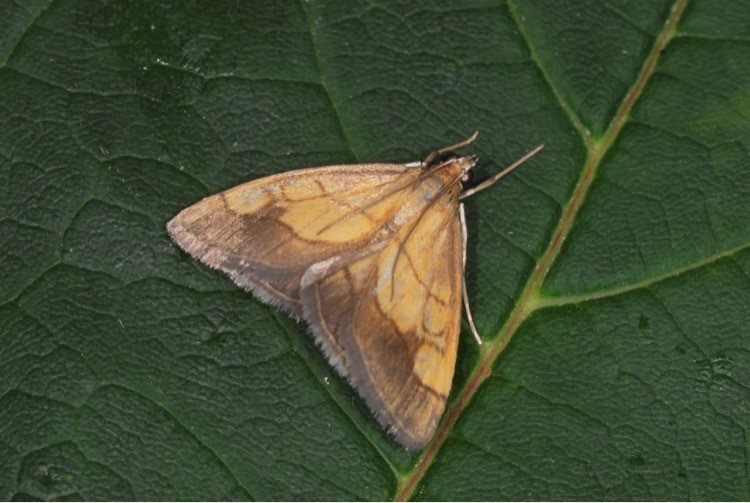
17th June 2022
A very warm night produced a single Rannoch Looper Macaria brunneata to a garden light trap in Thrapston (SP97). This is the 2nd VC32 record of this migrant species, following on from a single moth taken in Northampton on 28.vi.2021 . Other examples appear to have been noted in recent days through other southern and eastern counties.
3rd June 2022
A further two male Cydia servillana were attracted to the FAG pheromone lure, this time deployed for a couple of days/nights amidst several mature Goat Willows in Grafton Park Wood (SP98).
30th May 2022
The FAG pheromone lure was deployed in Fermyn Woods (SP98), hung on a reasonably mature Goat Willow tree. This attracted a single example of the Nationally Scarce Cydia servillana, which is known to be attracted to this lure. This is the 1st VC32 record for the species.
The lure trap had been left in situ for three days, being examined each day - the moth was inside on the third day.
21st May 2022
A daytime stroll through Fermyn Woods/Harry's Park Wood (SP98) yielded a record of Incurvaria pectinea. Several leaves were found (fortunately at about chest-height) on a single Birch tree along one of the grassy rides, each containing numerous larval mines of this species. This is the 5th VC32 record and the only record away from its only presently known location in and around Yardley Chase.
19th May 2022
A single Endothenia nigricostana was recorded to light in Salcey Forest (SP85). Although this represents the 9th all-time record for the county, it is only the 4th time it has been noted since 2000. It is maybe of interest to note that the moth was recorded at a very nearby location within the woodland in 1996.
19th May 2022
A number of Micropterix mansuetella were seen in Fineshade (SP99) during some butterfly survey work. This is the 1st VC32 record for a moth which may be overlooked. Having said that, I have searched for this within the Fermyn Woods complex over the years and have failed to record it. Of note: this species was also recorded for the first time this week in neighbouring Leicestershire/Rutland - VC55.
26th April 2022
Four larval cases of Coleophora paripennella were located on Common Knapweed along shaded rides within Fermyn Woods (SP88). This is the 9th VC32 record, but only the second time that the larval cases have been noted and the 4th time recorded since 2000. The species is widely distributed throughout the UK and is likely to be under-recorded locally. The feeding damage on Knapweed was extremely noticeable (see image below) and so now is a good time to look for the species. That said, I failed to locate any larval cases along an open, sunny track leading into the woods where Common Knapweed is plentiful.
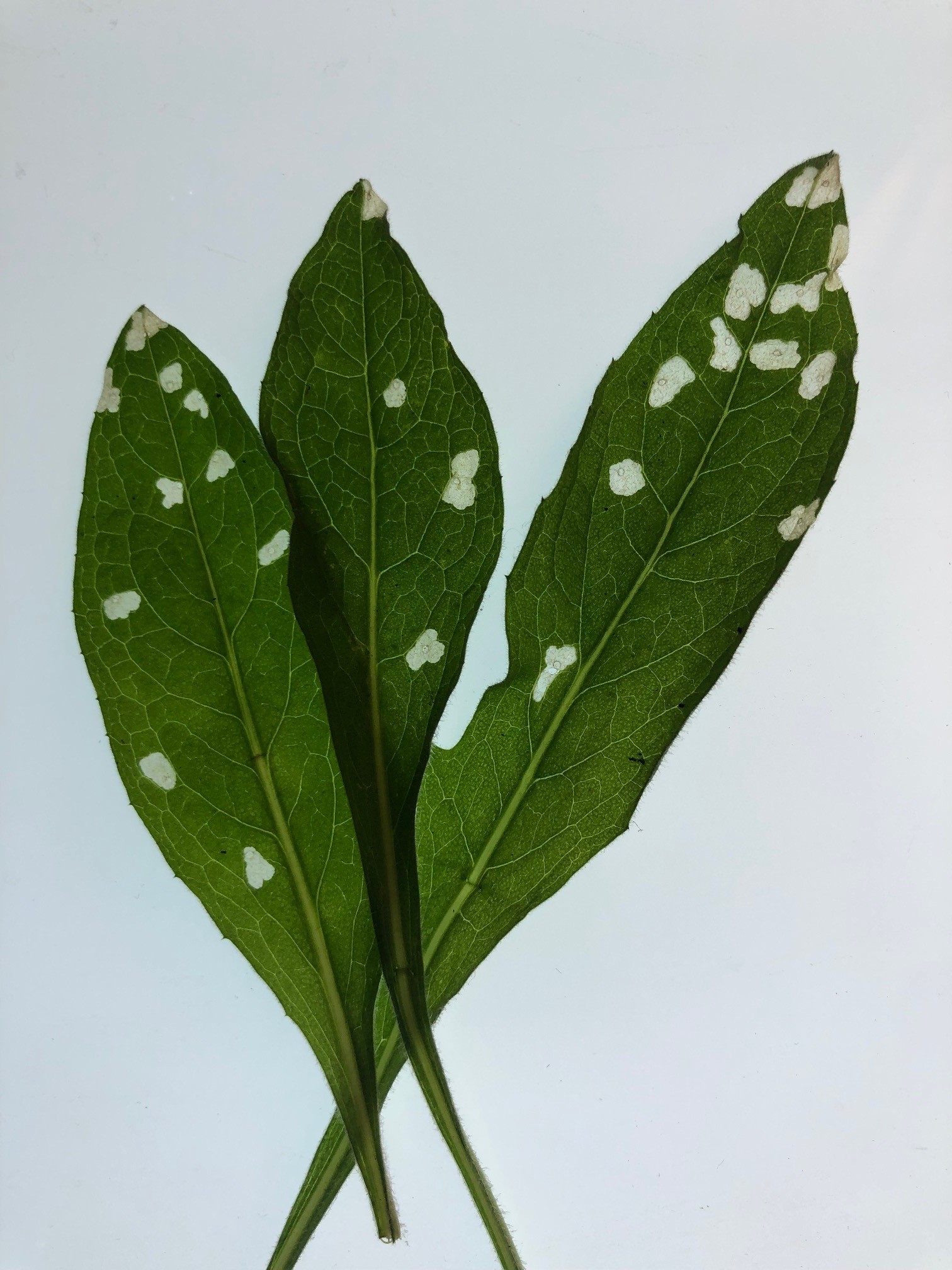
13th April 2022
The first of a number of Pammene agnotana recorded to pheromone lures was of one attracted to the SAL lure (for Sallow Clearwing) in Cogenhoe (SP86), subsequently confirmed by dissection. This represents the 2nd VC32 record. The 3rd county record was of another singleton to lure, this time in Bedford Purlieus (TF00) on 20th April, also confirmed by dissection. A further as yet unconfirmed example was recorded to the FUN lure at Farthinghoe NR (SP54) on 21st April. It is interesting to note that the species has not apparently been recorded in recent years, despite several recorders using pheromone lures at this time of year, and from the geographical spread of these three records, it appears to be established throughout VC32.
25th March 2022
Approximately 15 Adela cuprella were recorded at Old Sulehay quarry area (TL09).
This is the 6th VC32 record, but also the first confirmed record for the species within the county in over 80 years (last was 4th May 1939, Weekley Hall Woods). The moths were only seen around three mature Sallow trees in the entire quarry area, and mostly remaining high-up near the tree tops, but occasionally descending briefly before climbing back to their more usual height. I have seen the species reported on social media in other counties, so perhaps it's having a "good year".
22nd March 2022
Several over-wintering larvae of Apodia bifractella were located within the seedheads of Common Fleabane in Grafton Park Wood (SP98). This is the 6th VC32 record for the species, but the first time recorded in the larval stage. The larval hibernaculum (in which it also pupates) is a tough, robust spinning, firmly secured to the receptacle at the base of the remaining seeds (I'm not a botanist, so I hope I have correctly named that part of the flower!), but is not easily visible at a glance. It would be worth collecting a few seed heads for closer examination at this time of year as other records may be achieved in this manner.
24th February 2022
Please find a link here to the annual VC32 Moth Summary covering 2021. I hope it is an interesting read, and sufficiently covers the usual updates for our less-well recorded species, a summary of species that were added during the year and a few more items of interest too.
I apologise if anything appears to have been missed! I would like to take this opportunity to thank everyone who has supplied their moth records, be this directly to me or via iRecord, etc. These records will be sent over to the National Moth Recording Scheme at some stage soon (I can confirm that otherwise, the scheme is up-to-date with all VC32 data up to December 2020). Also to note that the distribution maps/phenology images have also been updated and are now available via the species write-up pages. This is an entirely manual operation, requiring the species output maps to be individually copied from MapMate, saved as a JPG file, and then uploaded to the server. There is significant opportunity for miss-typing of file names, so if you do spot something "not quite right", do please let me know!
16th February 2022
Two mines of the Nationally Scarce Phyllonorycter ulicicolella were located on Gorse in Weekley Hall Wood (SP88). This is the 1st VC32 record for this hard-to-locate species.
In my limited experience of finding this species in other counties, it seems to prefer the smaller stems, and plants which exhibit slightly softer spines (of course this may simply be that these plants are easier on the hand when examining for mines...!). I have heard annecdotal evidence that there may be a preference to feed on Western Gorse rather than Common Gorse.
6th February 2022
The UK Acer-feeding Caloptilia species have been reviewed in a paper published recently in the Entomological Record. The paper warns of confusion over these species and specifically the current understanding regarding C. hemidactyla and C. honoratella in the UK (although neither have yet to be confirmed in VC32, but are now recorded in neighbouring vice counties). The paper advises that there may also be further similar species present in the UK, such as C. jurataea, which have yet to be added to the UK list.
Therefore, the following measures are adopted:
Any adults of Caloptilia species which exhibit a yellow costal mark should now be retained for dissection to confirm identity. This includes C. alchimiella and C. robustella (also, C. hemidactyla, C. azaleella, C. fidella, C. honoratella – not yet recorded in VC32), but also includes forms of C. ellongella, C. rufipennella & C. betulicola).
Larval leaf-rolls/leaf-cones from Field Maple, Norway Maple and Sycamore must now be retained and reared through to adult to confirm species identity (which may involve dissection, as described above).
*********************************************************************************************************************************************************************************************
John Ward
30th July 1937 – 23rd January 2022
Funeral arrangements:
Thursday 10th February,
1:30pm,
Kettering Warren Hill Crematorium (Rothwell Rd, Kettering NN16 8XE)
Followed by a gathering at the adjacent Telford Lodge Brewers Fayre (Rothwell Rd, Kettering NN16 8FX)
All are welcome to attend both/either.
Family asks that no floral tributes be made, but donations to either Butterfly Conservation or RSPB would be welcomed.
It is with considerable sadness that I have to announce the passing of John Ward, who died unexpectedly on Sunday, 23rd of January. As many of you will know John was the previous County Macro Moth Recorder for Northamptonshire/VC32, a role he held for some 30 years until he relinquished it in May 2015. John’s interest remained firmly with the macro moth species rather than the micros, proudly proclaiming himself to be a “Heart and Dart man".
John was instrumental in gathering macro moth records from all eras, poring over notebooks of earlier recorders for information and searching through specimens lodged in local museums.
He was therefore the driving force behind the digitisation of these data, eventually putting them into a single database (aided hugely by his wife, Brenda). This then enabled local distribution maps to be created for the first time. These were then added to a newly created website, along with a write up for every species that had ever been recorded in the vice county. John’s attention to detail in sorting through these records was nothing short of legendary, and his recall of species, sites and dates was most enviable! This information provided the impetus to search for some of the long-lost species within the county, including those that had not been recorded for many years. Very often these activities would take the form of a moth group field trip, an activity that continues to this day.
Away from his duties as County Moth Recorder he spent a lot of time out of county with his good friend Derek Howton. The pair would travel the length and breadth of the United Kingdom in search of rare and elusive species that could not be seen locally. This nasty little habit has of course rubbed off on the current county recorder.
After retiring as the CMR, he directed his efforts into completing a book documenting the current state of Northamptonshire’s macro moths. “The Larger Moths of Northamptonshire & the Soke of Peterborough” was privately published in 2015. The tome includes comprehensive notes on some of the earlier recorders, and their contributions to our knowledge base. It also contains a very handy guide to some of the local sites, many of which have been visited by the moth group over the years.
On a personal note, I owe John a huge debt of thanks. I first met him around 1995, at which point he immediately took me under his wing (clearly my identification skills were so awful, he had no choice). John spent a lot of time teaching me about moths and taking me to the best moth sites in the county. He would often attempt to lure me into the dark side of slug and snail identification. I somehow resisted, but still have an inexplicable soft spot for both White-lipped and Brown-lipped Snails…
John was hugely generous with his time and knowledge for which I will always be grateful. I will cherish the time we spent in his study, mulling over the state of moths, sipping cups of coffee ferried in at regular intervals by Brenda.
Our thoughts are with Brenda, and his close family and friends.
John, may your Heart & Darts be plentiful, with the occasional ab. lineolatus thrown in for good measure.

*********************************************************************************************************************************************************************************************
14th January 2022
An indoor record of Duponchelia fovealis in Rothwell. This adventive speices does crop-up from time to time, often as a presumed result of the horticulture trade. The recorder in this instanace theorised that the moth may have entered the house as a pupa within a Poinsettia plant given as a Christmas gift. However it arrived, this is the 4th VC32 record.
2nd January 2022
It's that time of year when I wish all a Happy New Year, and to make a request for any outstanding moth records for 2021 (or indeed any others you may have lurking from previous years) to be sent to Mark Hammond as soon as possible please, so that I can assimilate records, run the necessary checks and write the report for the year.








